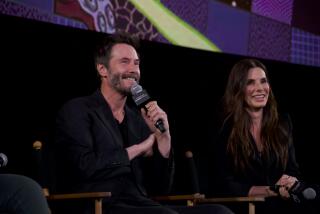Review: ‘Gravity’ has powerful pull thanks to Sandra Bullock, 3-D

Kenneth Turan reviews ‘Gravity,’ starring Sandra Bullock and George Clooney. Video by Jason H. Neubert.
- Share via
“Gravity” is out of this world. Words can do little to convey the visual astonishment this space opera creates. It is a film whose impact must be experienced in 3-D on a theatrical screen to be fully understood.
Though the strong work of Sandra Bullock and George Clooney — the only two actors who appear on camera — is essential to what the film accomplishes, the great lure of “Gravity” is the way director Alfonso Cuarón, cinematographer Emmanuel Lubezki and visual effects supervisor Tim Webber have collaborated to make us feel we’re stranded in outer space ourselves, no questions asked.
From its very first image of the shuttle Explorer and some of its astronauts floating close to 400 miles high, with a mammoth planet Earth huge behind them, “Gravity” revels in its ability to create images that convey the beauty, enormity and terror that being so, so far out there implies.
PHOTOS: Sandra Bullock: Career in pictures
Not only does that first image knock us out, but Cuarón and company up the ante by spinning it out into a bravura sequence that lasts for 13 minutes without a cut. The director has done long scenes before — a seven-minute segment in “Children of Men” is especially memorable — but he’s never pulled one off with all the built-in barriers of working in a facsimile of outer space.
Those barriers were so steep that Cuarón, one of the most accomplished directors around (everything from “Y Tu Mamá También” to “Harry Potter and the Prisoner of Azkaban”) ended up spending nearly five years on the project.
Once the “Gravity” team realized that the only way to achieve the painstaking photorealism the project demanded was to seamlessly combine live action, computer animation and CGI, new systems had to be invented and new ways of using existing equipment explored. Even computer-controlled factory robots usually employed on automobile assembly lines were repurposed for cinematic uses.
The new technology also made possible what Lubezki calls “elastic shots,” which go seamlessly from an exterior wide view to a subjective point of view from inside a space helmet. When you add in the exceptional way 3-D technology is used to bring reality to an unreal situation, the result is a level of verisimilitude unprecedented for a story like this.
Because the film’s pair of protagonists spend a big chunk of their time buried in space suits, with the limited facial visibility that implies, it was critical to have actors with the kind of instantly identifiable star personas that Bullock and Clooney enjoy to keep us involved in the personal dramatics of the story.
This is especially necessary because it’s also clear that “Gravity’s” “lost in space, eager for Earth” scenario is on one level an unapologetic B picture exercise where whatever can go wrong most certainly will.
But while the core story of “Gravity” is pure genre down to the workmanlike nature of chunks of its dialogue, it makes the most of that situation by having a formidable narrative drive, a plot smartly worked out to the smallest, most persuasive detail, and an intense, immersive score and sound design by composer Steven Price.
PHOTOS: Billion-dollar movie club
As a result, “Gravity” puts you completely on edge, starting with type on the screen that explains that way out there, “there is nothing to carry sound. No air pressure. No oxygen. Life in space is impossible.”
Having established its location as a bad place for something bad to happen, the film’s screenwriters (Cuarón and his son Jonás) spend time with two of the astronauts floating around the shuttle, Matt Kowalski (Clooney) and Dr. Ryan Stone (Bullock).
As written and performed, Mission Commander Kowalski is for better or worse a cocky type as much as a character. He’s the garrulous “that reminds me of a story” space veteran who is introduced having fun maneuvering around space with a new toy, a portable jet pack.
“You’re the genius,” he says to Mission Specialist Stone. “I drive the bus.”
If Kowalski couldn’t be more at ease, brainy scientist Stone is the opposite. She’s the nervous greenhorn, trying to survive her first time in space and working hard doing the futuristic version of replacing a dead battery as Mission Control (a heard but unseen Ed Harris) kibitzes the situation.
PHOTOS: Hollywood backlot moments
Suddenly, very suddenly, everything falls apart. An unexpected amount of debris is headed toward the shuttle faster than a speeding bullet, and before you can say “Buck Rogers in the 25th Century,” Stone is floating untethered in outer space, all communication cut off, alone, alone, alone. And that is only the beginning.
One of the things that makes “Gravity” stand out is that its visuals of interior space are as striking as what it shows us of outer space. One particular sequence, of Stone gliding with weightless ease through spaceship corridors, is remarkable for its seeming effortlessness. In fact, the amount of work necessary to achieve that effect — including the invention of a 12-wire pulley system attached to Bullock and controlled by some of the puppeteers who worked on the theatrical version of “War Horse” — almost defies description.
No one has more screen time in “Gravity” than Bullock, and no one makes better use of it. Her bleak working conditions in this effects-heavy film demanded physical dexterity and the ability to withstand long periods of isolation, but through it all her gift for connecting with an audience, so essential for this kind of film, never fails her.
Director James Cameron is one of the small number of people thanked at the end of “Gravity,” and this couldn’t be more appropriate. His groundbreaking “Avatar” opened the book on the modern artistic use of 3-D, and this film is the next chapter — the most accomplished, persuasive use of that technology we’ve seen from then until now.
‘Gravity’
MPAA rating: PG-13 for intense perilous sequences, some disturbing images and brief strong language
Running time: 1 hour, 30 minutes
Playing: In general release
More to Read
Only good movies
Get the Indie Focus newsletter, Mark Olsen's weekly guide to the world of cinema.
You may occasionally receive promotional content from the Los Angeles Times.








